This article explores how personalized tacting in ABA (Applied Behavior Analysis) can truly make a difference in enhancing communication skills for children, especially those with autism. By weaving tacting into everyday moments—like during meals, playtime, and community outings—caregivers can nurture language development, emotional expression, and social skills. This approach not only helps children grow but also fosters their independence and confidence.
Imagine sitting down for dinner and using that time to encourage your child to express their thoughts and feelings. Or think about how playtime can become a wonderful opportunity for them to practice new words and social interactions. These small, everyday moments can lead to significant growth, and as caregivers, you have the power to make that happen!
As you integrate these tactics into your daily routines, remember that you're not alone in this journey. Many parents face similar challenges, and sharing experiences can create a sense of community. So, let’s explore this together! Your efforts can lead to meaningful changes in your child's life, helping them to communicate better and feel more confident in their interactions.
Enhancing communication skills in children, especially those on the autism spectrum, is both vital and rewarding. Tacting, a key part of Applied Behavior Analysis (ABA), is a powerful tool for parents and caregivers. It helps little ones express their thoughts, feelings, and observations in meaningful ways.
By exploring practical examples of tacting in everyday life, we can unveil strategies that not only foster effective communication but also build confidence and independence in children. But how can caregivers seamlessly weave these tactics into daily routines for lasting impact and growth? Let’s explore this together!
Rori Care - ABA Therapy emphasizes the importance of personalized tacting ABA example strategies in helping our little ones thrive. A tacting aba example demonstrates that tacting is all about labeling objects, actions, or feelings, which helps kids express their thoughts and observations in a meaningful way. Each behavioral plan is custom-designed, ensuring that it resonates with what your child loves and experiences daily.
By teaming up with qualified behavior analysts, parents can create tailored tactics that not only boost communication but also blend seamlessly into everyday interactions. This fosters a more natural and engaging dialogue. Imagine using visual aids and routine-based prompts as a tacting ABA example to assist kids in expressing themselves across different contexts—this is where successful strategies shine!
These methods are backed by evidence-based strategies and continuous assessment, leading to improved social skills and emotional expression. Plus, measurable objectives are set to track progress, with significant improvements noted in 90% of youth when the suggested hours are fully executed with active caregiver participation. This really emphasizes the importance of adaptive treatment strategies based on progress reports.
Let’s explore this together! We’re here to help you every step of the way!

Incorporating a tacting aba example into everyday situations can significantly enhance communication skills for kids with autism! During meal times, why not encourage your little ones to name foods, colors, or textures? This simple act can turn a routine activity into a fun learning opportunity. For example, when they identify a 'red apple' or describe the 'crunchy texture' of a carrot, they’re not just expanding their vocabulary—they’re also learning to express their preferences and observations.
Playtime is another fantastic opportunity for tacting practice! You can prompt your child to describe actions or objects, like saying, 'This is a red ball' or 'I am throwing the ball.' These interactions create a lively language environment that promotes independence and boosts social skills. Research shows that consistent tacting aba example practice during meals or play can enhance interaction skills and foster a sense of belonging.
Experts agree that these simple yet effective strategies can greatly boost a young person's confidence in expressing themselves. By weaving tacting into daily activities, caregivers can help individuals with autism navigate their surroundings more effectively, ultimately improving their overall communication abilities. Let’s explore this together!

The tacting aba example is such a vital tool for helping our youth with autism develop those important social skills! Imagine during group activities when parents can gently guide their kids to recognize and express the emotions of their peers. For example, a child might say, 'She looks happy.' This simple practice not only boosts communication but also nurtures empathy and understanding—key ingredients for meaningful social interactions.
Studies show that kids who engage in a tacting aba example during peer interactions see remarkable improvements in their ability to connect with others. This leads to better social integration and stronger relationships! So, how can we help our young ones recognize emotions? Effective strategies include:
By weaving these tactics into our routines, we can empower our children to navigate social situations with confidence and purpose.
And let’s not forget about the role of caregiver education in this journey! When we equip caregivers with a solid understanding of ABA principles and strategies, such as a tacting aba example, they can make informed choices that positively impact their child’s progress. This not only enhances the effectiveness of tactics like tacting but also helps everyone involved feel more connected and supported.
As psychologist Dr. Emily Johnson wisely points out, 'Teaching youngsters to articulate their observations about others' emotions not only builds their communication skills but also fosters deeper connections with their peers.' Through active involvement and education, we can empower caregivers, reducing stress and improving overall family dynamics. So, let’s explore this together and support each other in this wonderful journey!
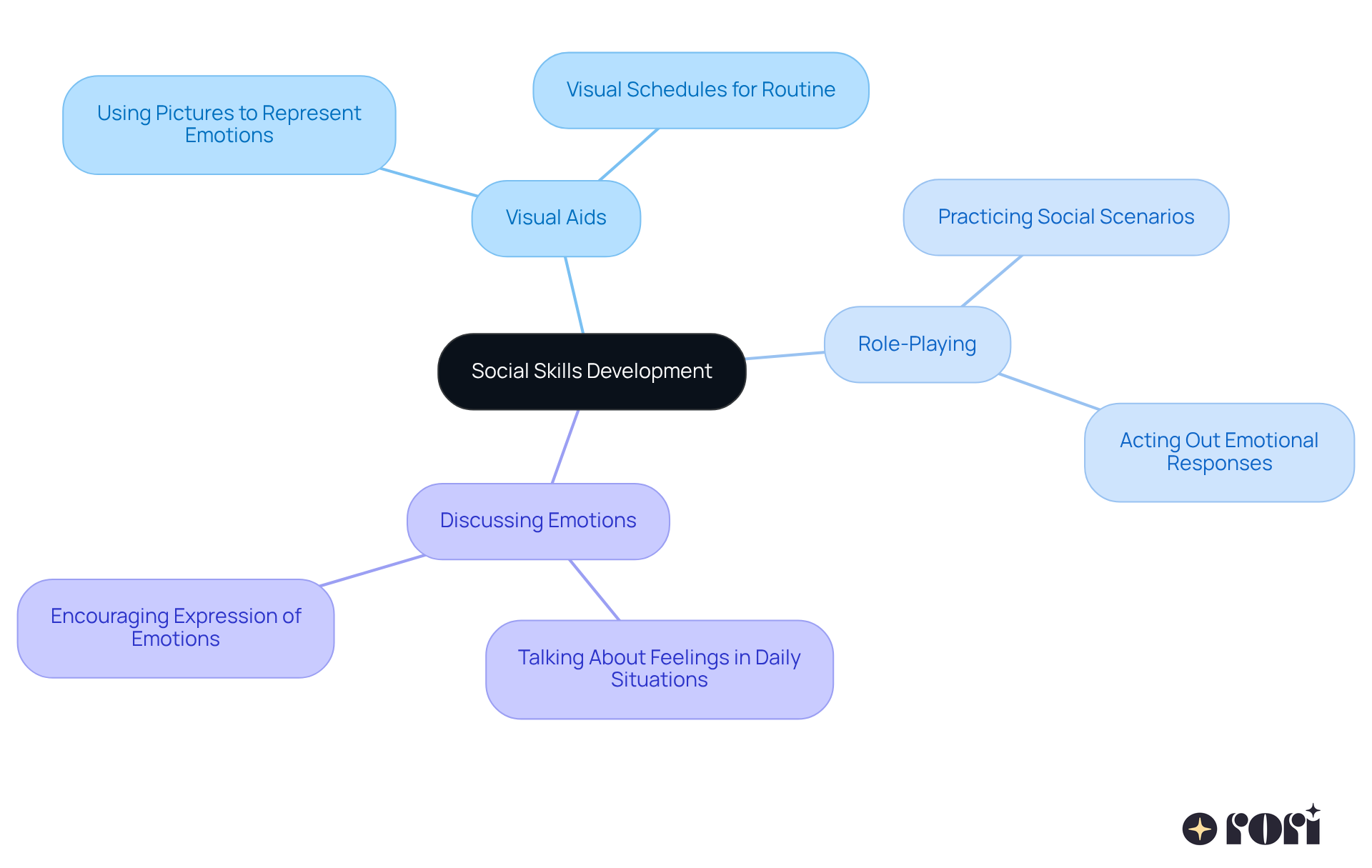
Teaching our kids to manage their emotions is so important for building emotional intelligence! 🌟 As parents, we can set a great example by using phrases like "I feel sad when..." or "I am happy because..." This not only helps our little ones express their feelings verbally but also nurtures healthier emotional interactions.
Research shows that when kids express their feelings, it can boost their communication skills and emotional control, especially for children with autism. By regularly practicing these phrases, we empower our children to share their feelings, which can lead to stronger social connections and greater emotional resilience.
Successful stories reveal that when parents actively engage in this process, kids become more adept at recognizing and expressing their emotions—an essential part of their overall growth. One therapist noted, "Expressing emotions is crucial for young individuals to comprehend and handle their feelings effectively."
Additionally, a tacting ABA example of using co-regulation strategies in practice can help develop emotional resilience. It highlights how vital it is to teach our kids to articulate their emotions verbally. Plus, participating in social interaction group therapy, led by skilled therapists, can further enhance these communication skills by providing kids with a safe space to practice emotional expression among peers. This nurturing environment ultimately fosters better relationships and competence.
Let’s explore this together! We’re here to help you every step of the way!
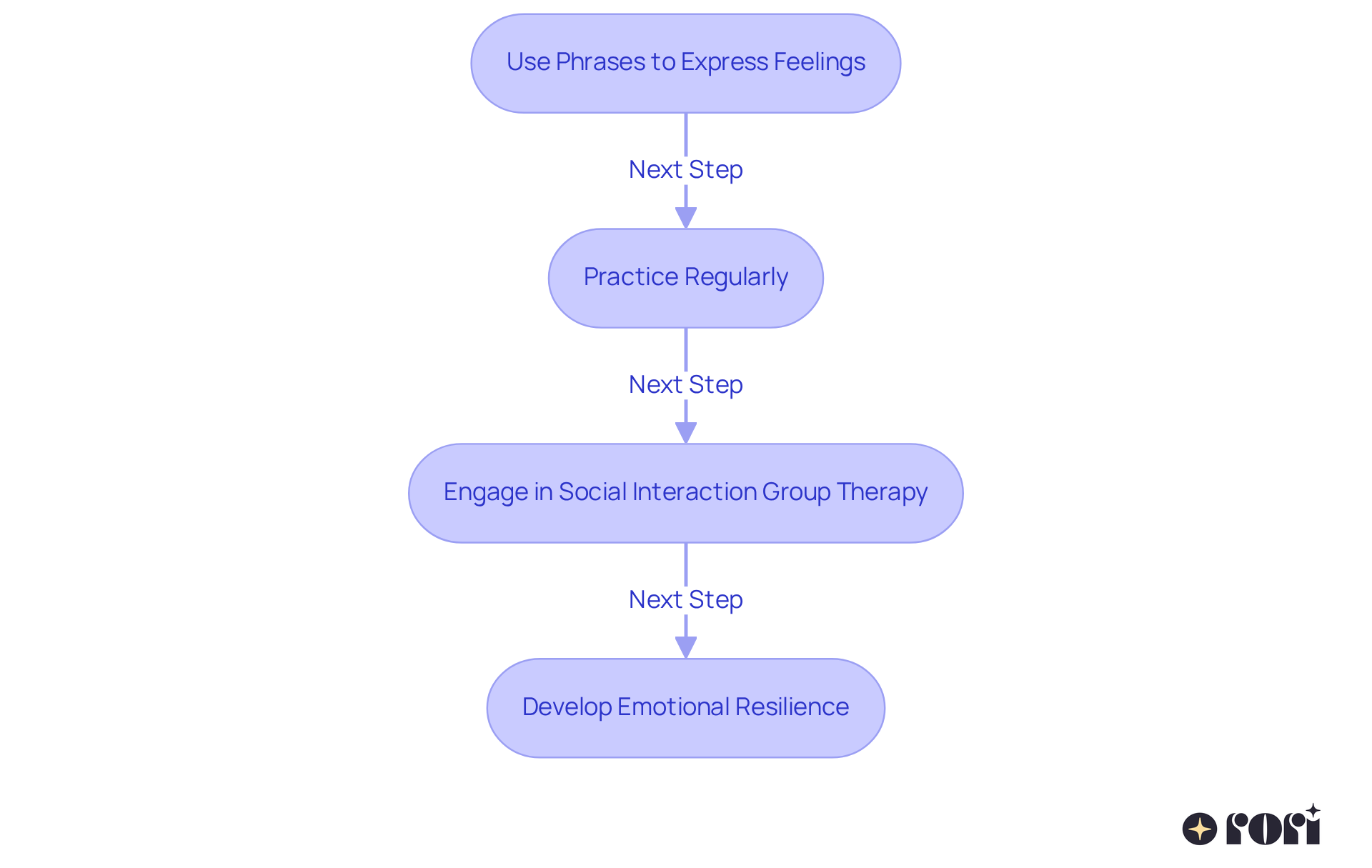
Tacting plays a crucial role in fostering cognitive growth, especially during storytime interactions. For instance, parents can boost their children's critical thinking by asking questions like, 'What do you think will happen next?' or encouraging them to identify characters and their motivations. These prompts not only engage youngsters but also enhance their understanding and ability to foresee outcomes.
Studies show that storytelling significantly improves expressive and receptive language skills in kids, which are essential for reading and writing. Plus, interactive storytelling methods—like asking questions while reading—have been shown to enhance young learners' cognitive abilities, including critical thinking and problem-solving skills. By incorporating a tacting aba example into storytime, parents can foster a dynamic learning environment that nurtures curiosity and understanding. These are essential components for effective autism therapy.
This approach not only enriches the storytelling experience but also empowers young individuals to think critically and creatively, laying a solid foundation for their future education. Let’s explore this together and see how we can make storytime a magical learning moment!
An effective application of tacting ABA example can be found in numerous environments, each providing unique opportunities for young individuals to enhance their communication skills. At home, parents can encourage their children to describe household items, which helps develop vocabulary and expressive language. For example, asking a little one to identify and explain the purpose of everyday objects like a 'spoon' or 'toothbrush' can strengthen their understanding of language in a familiar setting. When caregivers are informed about ABA principles, they’re better equipped to provide consistent support, as shown in a tacting ABA example, that complements professional interventions, ultimately reducing stress and improving family dynamics.
In school, teachers can prompt students to label classroom objects, incorporating the tacting ABA example into daily activities. This not only aids vocabulary acquisition but also helps young learners connect words with their meanings in a structured environment. Imagine a lesson that serves as a tacting ABA example, where a teacher asks students to point out and name items like 'desk' or 'window'—this reinforces their learning through active participation. When caregivers get involved in this process, they can make informed decisions, allowing them to align their support with the strategies used in the classroom.
Community settings also present rich opportunities for a tacting ABA example. Parents can guide their children to identify signs, people, or objects in their surroundings, enhancing their ability to communicate effectively in real-world situations. For instance, during a stroll in the neighborhood, caregivers can encourage their kids to spot different types of vehicles or recognize familiar faces, thus broadening their social interaction skills. The insights gained from caregiver training empower them to actively participate in these learning experiences, leading to better behavioral outcomes for their children.
Quotes from educators highlight the importance of tacting in these settings. As Fred Rogers wisely said, 'Play is serious learning,' reminding us that engaging in these activities is not just fun but crucial for cognitive and social development. By incorporating tactful strategies in home, school, and community environments, caregivers and educators can significantly boost youngsters' communication abilities, preparing them for more complex interactions ahead. Let’s explore this together!

Parents can significantly enhance their little ones' learning by seamlessly integrating tacting into everyday activities. For instance, during grocery shopping, parents can provide a tacting ABA example by encouraging their kids to recognize and label different fruits and vegetables. This interactive approach not only boosts vocabulary and communication skills but also transforms a routine task into a fun and engaging learning experience.
Research shows that such interactions during shopping can lead to improved language abilities and cognitive growth. Young ones learn to express their thoughts and observations in real-time, making these moments educational. Caregivers create an environment where learning is a natural part of everyday life. Plus, as caregivers deepen their understanding of ABA principles, they become better equipped to support their children's behavioral goals, leading to even better outcomes.
To make this experience even more enjoyable, parents can turn shopping into a simple game by asking their kids to find specific items on the shopping list. This way, the outing becomes an exciting learning adventure! This active participation not only empowers caregivers but also fosters consistency in learning, ultimately benefiting the development of the little ones. Let’s explore this together!
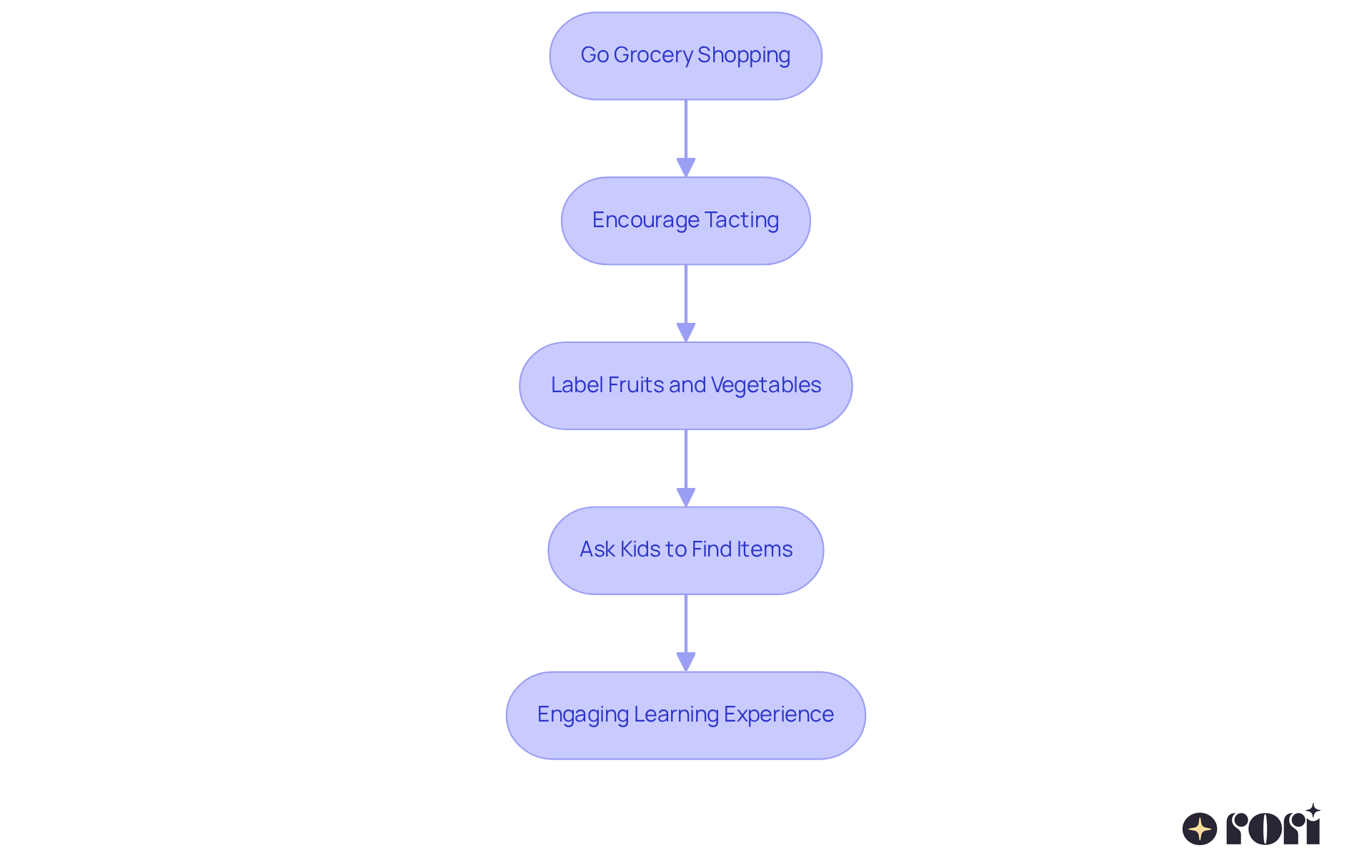
Using visual aids like picture cards can significantly enhance tacting ABA example skills in young people, particularly those with Autism Spectrum Disorders, ADHD, learning disabilities, and other behavioral challenges. These cards act as concrete symbols for feelings or items, helping kids make important connections. For example, when a child uses a picture card to express emotions, it not only aids in communication but also fosters emotional understanding. Parents can encourage their children to use these cards, which deepens their grasp of interaction dynamics and aligns beautifully with the principles of Applied Behavior Analysis (ABA) therapy.
Many success stories highlight how picture cards have led to significant improvements in communication skills. In one study, kids who engaged with visual aids experienced a noticeable increase in social interactions, showcasing the effectiveness of these tools. Therapists often mention that visual learning is especially beneficial for children with autism, as they tend to process visual information more readily than verbal cues. This method not only enhances their ability to share thoughts but also eases frustration by simplifying complex instructions.
Therapists share inspiring insights: 'Emotion charts help children identify and communicate their feelings, fostering emotional awareness.' This underscores how vital visual aids are in building confidence and encouraging interaction. Additionally, research indicates that integrating picture cards into communication strategies can lead to slight to moderate improvements in expressive language skills, making them a valuable resource in a tacting ABA example. It’s important to note that around 35% of autistic individuals are non-verbal or minimally verbal, highlighting the critical role of visual aids in communication. By equipping caregivers with these strategies, ABA therapy can effectively support children in developing essential verbal and social skills. Remarkably, 90% of young people show notable progress when suggested hours are fully utilized with active caregiver involvement.
Let’s explore this together and see how these tools can make a difference!
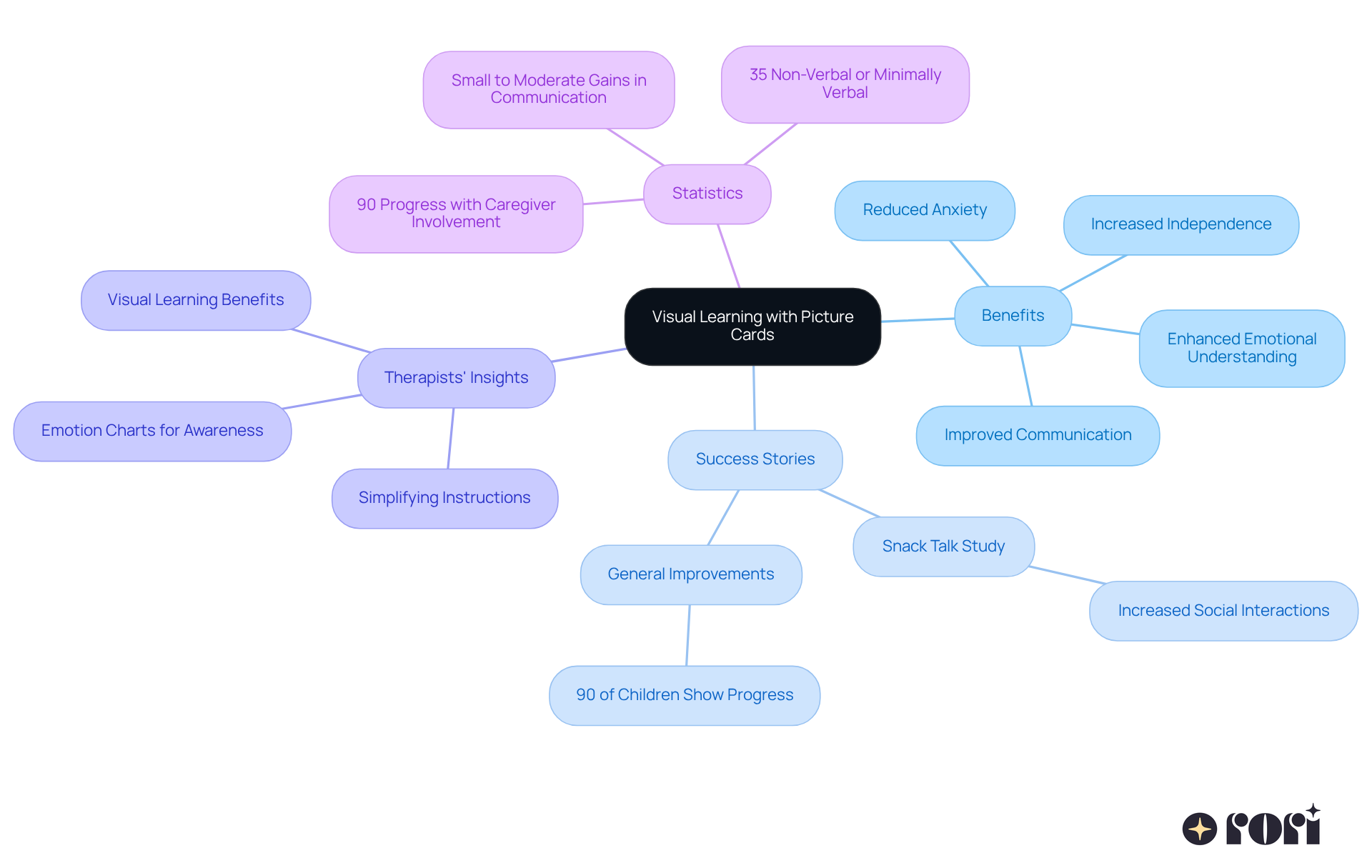
Incorporating reinforcement methods into tacting can really boost abilities in youngsters with autism! For instance, when a little one successfully labels an object, offering prompt praise or a small reward can serve as effective positive reinforcement. This not only encourages them to keep honing their interaction skills but also provides a tacting aba example that nurtures a sense of achievement and motivation.
Studies show that positive verbal encouragement is linked to enhanced self-assurance and better interaction skills in young individuals. In fact, research indicates that 87.18% of tact interventions yield excellent or high effect sizes, highlighting the effectiveness of these strategies. Successful examples include using verbal praise, like 'Great job!' or tangible rewards such as stickers, to reinforce the child’s efforts during play.
By consistently applying these reinforcement techniques, parents and caregivers can create a supportive environment that exemplifies tacting aba example and fosters the development of essential expressive abilities. Plus, educating caregivers enhances their capacity to provide the right support at home, complementing professional interventions and promoting consistency. With a deeper understanding of ABA principles, caregivers can make informed decisions that positively impact their child’s progress.
As one behavior analyst wisely noted, 'Reinforce the effort, celebrate the growth.' By blending these educational insights with reinforcement methods, caregivers can enhance their effectiveness in supporting their child’s development. Let’s explore this together!
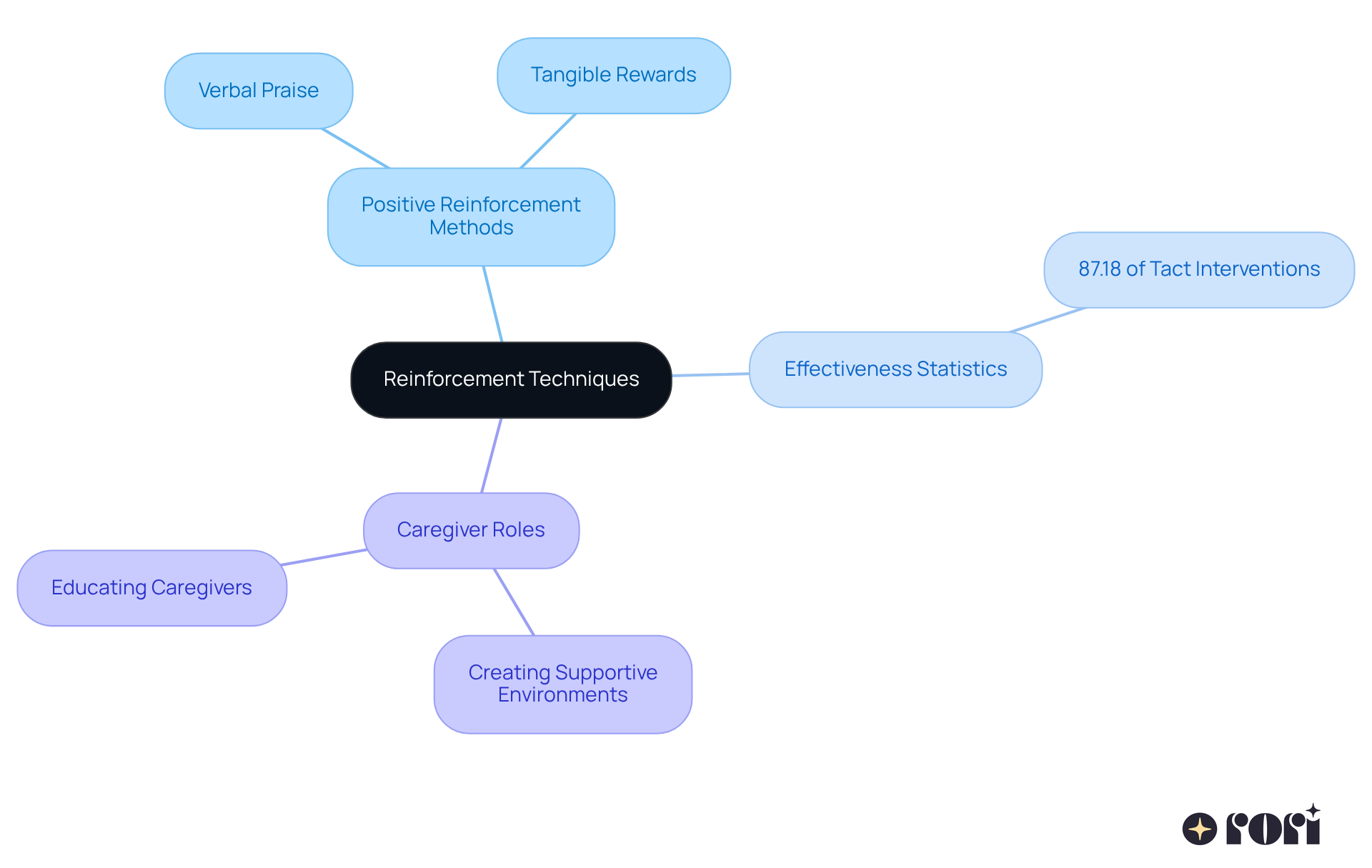
The tacting ABA example is crucial for improving instant communication and assisting kids with autism in becoming more independent! When parents encourage their children to express their needs and ideas, it boosts their confidence in social situations. This vital skill not only aids in daily interactions but also paves the way for future success in various aspects of life.
Studies show that children who develop strong verbal skills often achieve better outcomes in education and social integration. For instance, kids with a solid tact repertoire frequently enjoy enhanced social interactions, leading to more invitations for playdates and group activities. Isn’t that wonderful?
Child psychologists emphasize that effective communication is a cornerstone of personal empowerment. They believe that the ability to express oneself significantly influences future opportunities and relationships. By nurturing tacting ABA example skills, parents can effectively assist their children in building a pathway to independence and success. Let’s explore this together!
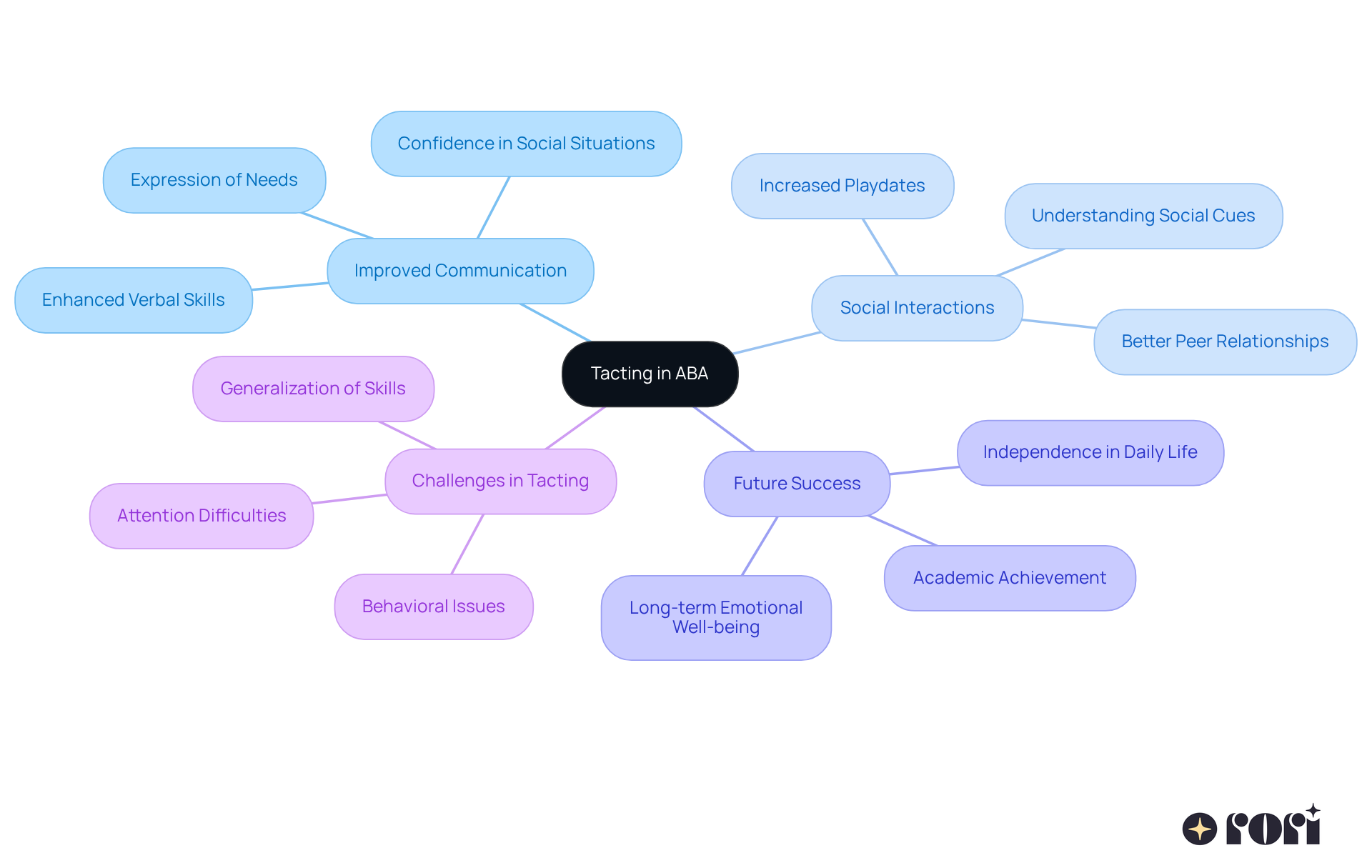
Tacting is such an important part of enhancing communication skills for children, especially those with autism. By focusing on labeling objects, actions, and feelings, tacting not only boosts vocabulary but also helps children express their thoughts and emotions more effectively. This personalized approach really shows how tailored strategies can make a big difference in a child's ability to communicate in various settings—whether at home, school, or out in the community.
One of the key insights from the article is how effective it can be to integrate tacting into everyday situations, like during meals or playtime. Plus, caregiver involvement is crucial in this process! Using visual aids, reinforcement techniques, and real-life applications can nurture social skills, emotional expression, and cognitive growth. These strategies create a supportive learning environment and lead to long-term benefits, such as increased independence and confidence in social interactions.
Incorporating tacting into daily life isn’t just about improving communication; it’s about building a bridge to a more connected and fulfilling life for children. By actively engaging in these practices, caregivers can create enriching experiences that promote learning and emotional resilience. As this journey unfolds, embracing these tactics will not only benefit the children but also strengthen the bonds within families and communities. Empowering children with effective communication skills today lays the groundwork for their success tomorrow. Let’s explore this together!
What is tacting in the context of ABA therapy?
Tacting is the process of labeling objects, actions, or feelings, which helps children express their thoughts and observations in a meaningful way.
How does Rori Care personalize ABA therapy for children?
Rori Care creates custom-designed behavioral plans that resonate with what each child loves and experiences daily, ensuring the tactics are tailored to their individual needs.
What role do parents play in the tacting strategies provided by Rori Care?
Parents team up with qualified behavior analysts to create tailored tactics that boost communication and blend seamlessly into everyday interactions, fostering natural dialogue.
What are some examples of everyday situations where tacting can be practiced?
Tacting can be practiced during meal times by encouraging children to name foods, colors, or textures, and during playtime by prompting them to describe actions or objects.
How can tacting enhance social skills for children with autism?
Tacting helps children recognize and express the emotions of their peers, leading to improved communication, empathy, and stronger social interactions.
What strategies can be used to help children recognize emotions during social interactions?
Effective strategies include using visual aids, role-playing scenarios, and discussing different emotional expressions in everyday situations.
What impact does caregiver education have on the effectiveness of tacting strategies?
Educating caregivers about ABA principles and strategies enhances their ability to make informed choices that positively impact their child's progress and fosters a supportive family environment.
What evidence supports the effectiveness of tacting strategies in improving communication skills?
Research indicates that consistent practice of tacting during meals or play significantly enhances interaction skills, with notable improvements seen in 90% of youth when caregivers actively participate.